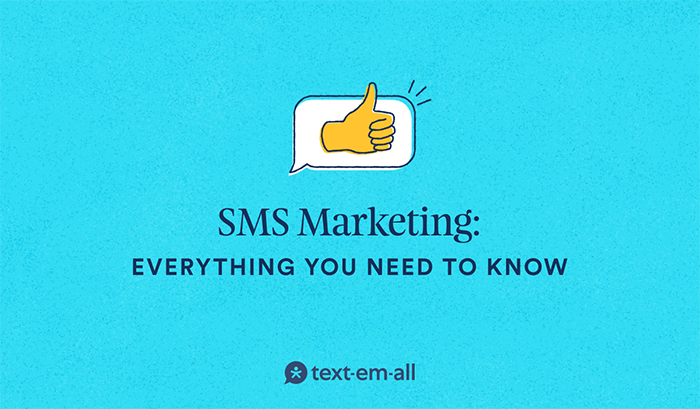
SMS marketing gives businesses a fast, direct way to reach customers. With open rates as high as 98% and most texts read within minutes, it’s one of the most immediate and effective marketing tools available. Whether sending updates, promotions, or reminders, SMS helps brands cut through the noise and connect on a personal level.
So, what is SMS marketing exactly? In this guide, we’ll break down how it works, the different types of messages you can send, real-world examples, and the benefits of integrating text messaging into your marketing strategy.
What Is SMS Marketing?
SMS marketing is a form of digital outreach that uses text messages to communicate with customers. It allows businesses to send short, targeted messages directly to people’s phones for things like promotions, alerts, or service updates.
Here’s how SMS marketing works: Customers opt in to receive texts from your business, usually through a form, website, or keyword. Once subscribed, you can use a text messaging platform to send personalized messages, track delivery and engagement, and automate future campaigns based on behavior or timing.
SMS marketing is built for mobile-first communication, making it ideal for reaching people wherever they are. And because it's permission-based, your messages go to people who’ve asked to hear from you, leading to stronger engagement and better results.
Types of SMS Marketing
There’s no one-size-fits-all approach to text messaging. The most effective SMS marketing strategies use a mix of message types depending on the goal—whether it’s informing, promoting, or engaging.
Transactional SMS Marketing
Transactional texts keep customers informed after a purchase or signup. These messages don’t promote anything directly but are essential for building trust and improving the customer experience.
Common examples include:
- Order confirmations
- Shipping and delivery updates
- Appointment reminders
- Account notifications
- Payment confirmations
By providing timely updates, transactional SMS helps reduce confusion, improve satisfaction, and increase repeat business.
Promotional SMS Marketing
Promotional messages focus on generating revenue. These texts are designed to drive traffic, boost sales, and spark interest in products, services, or events.
Common examples include:
- Limited-time offers and flash sales
- Product launches
- Personalized coupons or loyalty rewards
- Event announcements
- Seasonal campaigns
Because SMS is short and direct, promotional messages are great for grabbing attention and prompting fast action.
Engagement SMS (Conversational Texts)
Engagement texts create two-way conversations with customers. These messages are interactive and often triggered by user behavior, helping support, inform, or convert prospects in real time.
Common examples include:
- “Reply YES to confirm your appointment.”
- “Text HELP for support options.”
- "Reply DEAL for this week's promotion."
Some platforms even use AI to power smart replies, allowing for personalized back-and-forth exchanges that deepen engagement.
Benefits of SMS Marketing
SMS marketing delivers results quickly and consistently. Whether you're nurturing leads or driving last-minute sales, these benefits show why it’s one of the most effective tools in your marketing toolkit.
High Open-Rates
SMS marketing texts reach your audience fast, with nearly unmatched visibility. Messages have a 98% open rate, far exceeding what most email campaigns achieve. With people checking their phones throughout the day, your texts are more likely to be seen and acted on.
Immediate Delivery and Engagement
Text messages are delivered instantly, and most are read within minutes. If you need to promote a flash sale, share an urgent update, or nudge a customer toward a decision, SMS gives you real-time access to your audience.
Direct & Personal
Texting feels personal. It’s the same channel people use to talk to friends and family, which makes it an ideal format for building brand trust. You can personalize messages with names, order details, and relevant offers for a tailored customer experience.
Broad Reach
Almost everyone owns a mobile phone, which means SMS gives you access to nearly all of your customers, with no apps or logins required. It’s an easy way to reach people wherever they are.
Higher Engagement Rates
Consumers are more likely to click on links, respond to prompts, or follow up on offers when messages arrive via text. Compared to email or social media, SMS consistently delivers higher engagement and conversion rates.
7 Proven Techniques for Effective Marketing
To make the most of your SMS marketing efforts, follow these tried-and-true best practices:
Stay Compliant
Always follow applicable SMS laws like the TCPA and CTIA guidelines. These require opt-in consent, opt-out options, and limits on when and how you send texts.
Obtain and Respect Consent
Never send texts to people who haven’t explicitly opted in. Make it easy to unsubscribe at any time and honor opt-out requests immediately.
Segment Your Audience
Tailor your messages by grouping contacts based on behavior, location, or past interactions. Segmentation helps improve relevance and engagement.
Keep Messages Concise
SMS works best when it’s short and to the point. Aim for under 160 characters when possible to keep your content scannable and effective.
Write Clear CTAs
Let recipients know exactly what to do next—whether it’s clicking a link, using a promo code, or replying with a keyword.
Sync With Email and Other Channels
Use SMS as part of a broader communication strategy. Align your messaging across email, social media, and your website for a consistent customer experience.
For an in-depth exploration of SMS best practices, head over to our blog where we dive deeper into each of these strategies and more!
SMS Marketing Ideas to Try
Once you understand how SMS marketing works, it’s time to put it into action. The key is to deliver value quickly and clearly. Below are popular use cases that can help you engage your audience and drive results.
Flash Sales
Promote limited-time discounts to create urgency and encourage fast action. SMS is perfect for short windows—your audience sees the offer right away.
Loyalty Offers
Reward returning customers with exclusive codes, early access to sales, or special perks. These messages help boost retention and brand loyalty.
Product Drops
Notify subscribers when new products are available. Whether it’s a seasonal launch or a restock, SMS keeps your most engaged customers in the loop.
Event Alerts
Send reminders or invitations for webinars, local events, or in-store promos. Timely texts can increase attendance and reduce no-shows.
Abandoned Cart Reminders
Nudge shoppers to complete their purchases by reminding them of items they left behind. You can also add a promo code to sweeten the deal.
Giveaways
Drive engagement by promoting contests or sweepstakes. Text-to-enter campaigns can increase opt-ins and grow your list while generating excitement.
Tap Into the Potential of SMS Marketing With Text-Em-All
SMS marketing gives businesses a direct, personal, and incredibly effective way to reach customers. With open rates near 98%, lightning-fast delivery, and higher-than-average engagement, it’s one of the most scalable and cost-efficient tools available today.
For reminders, promotions, or updates, SMS provides speed, effectiveness, and meaningful connection.
Ready to get started? Explore Text-Em-All’s SMS marketing tools to send smarter texts, reach more people, and grow your business faster.












